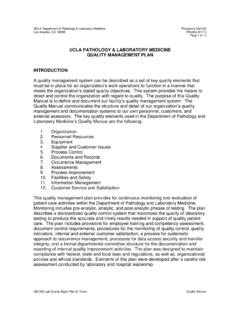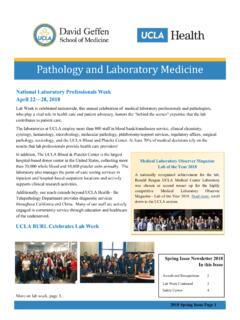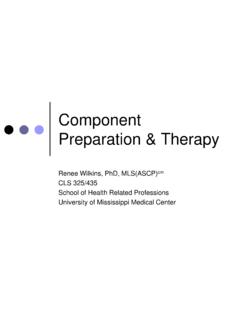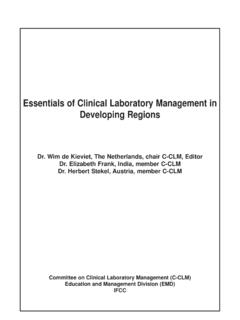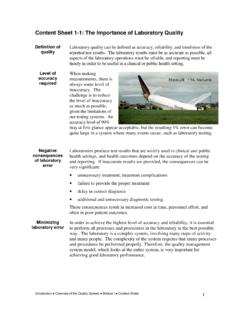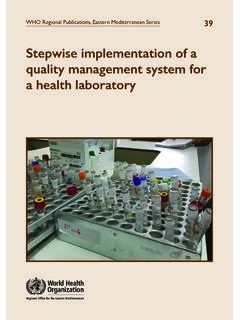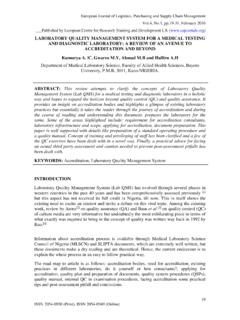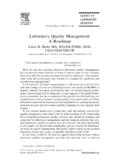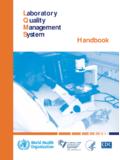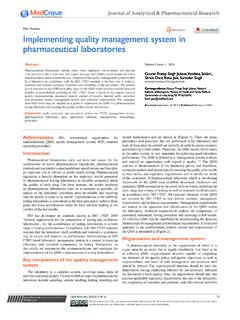Transcription of Quality Management in the Laboratory - UCLA
1 Quality Managementin the LaboratoryAnn Shadler, MT(ASCP)SBBC linical Laboratory ManagerDepartment of Pathology & Laboratory MedicineLearning Objectives Define key elements of a documented Quality Management system (QMS) Describe the role of the Laboratory director in developing, implementing and overseeing the program Identify criteria that evaluate a QMS for effectiveness Quality Terminology Quality Quality Control Quality Assurance Quality IndicatorMore Quality Terminology Quality Improvement Quality Management system Quality ManagementGlossary of Commonly Used Quality Terms: Attachment pages 1-2 Progression of Quality 1940s 1960s: Laboratory Quality control (QC) 1970s: Proficiency Testing 1980s: Quality Assurance (QA) 1990s: Quality Systems History of the QMS 1995 -FDA Guideline for Quality Assurance in Blood Establishments AABB incorporated the Quality Management concepts into its accreditation standards 1999 -CLSI published guideline on QM concepts 2003 -ISO 15189, Medical Laboratories publishedWhy have a QM Program?
2 Enhances these outcomes: Ability to reduce or eliminate medical error; the likelihood of meeting customer requirements; the potential for successful governmental and accreditation assessments; and sustainable attainment of Quality Requirement CLIA Regulations( - ) Subpart K Quality system for Non-Waived Testing CMS approves accrediting organizations CAP -COLA AABB -TJCC hoosing a QMS Framework Quality system Essentials (QSE) Similar elements described AABB-CLIA CAP-FDA CLSI-ISO 15189 QSE According to CLSI Document HS1-A2 OrganizationDocuments/RecordsPersonnelIn cidents / ErrorsEquipmentAssessmentsSupplier IssuesProcess ImprovementProcess ControlCustomer ServiceFacilities / SafetyInformation ManagementComponents of a QMS: Attachment pages 3-4 The Quality Manual Defines and documents the QMS Tool for communicating operational guidelines to your staff and to external assessors Provides the opportunity for staff to see their integrated roles and responsibilities Quality Manual TOC.
3 Attachment page 5 Quality Management Plan A document that describes the Laboratory s overall QM program Includes a statement of the Laboratory s commitment to Quality and patient safety Spells out the types of monitoring that will be performed Includes major planned Quality improvement activities Specifies how Quality and safety information is to be collected and disseminatedQuality Management Plan Required by CAP ( ) Provides reasonable assurance that the Laboratory Complies with laws and regulations Meets defined standards of Laboratory practice Engages in Quality improvement activities QM Plan and Program must be implemented!Key Elements of a QM Program Written Quality Manual including a QM Plan Implementation Data collection Analyze and evaluate data Identify opportunities for improvement Implement improved processes Evaluate improvements Communicate resultsWhere can you get ideas for improvement? Incident reports Internal assessments Institutional goals, vision, and mission Lean or Six Sigma processes Customer feedback Employee suggestions Utilization reportsMonitoring Quality Indicators Select indicators which monitor the Quality of performance Pre-analytic variables: specimen submission and handling Analytic variables: diagnostic accuracy Post-analytic variables: report adequacy and integrity UCLA Quality Indicators: Attachment pages 6-7 Acting on Quality Indicator Data identifying opportunities for improvement; implementing corrective action; performing a root cause analysis; developing a Quality improvement strategy; modifying targets or action thresholds; reporting to interested parties.
4 And deciding to continue monitoring or stop monitoring the system Internal Audits Audits should be formally planned and organized Target operations that have the highest risk for non-conformance and impact on patient care Tracer methodology audits QSE: Organization self assessment: Attachment pages 8-9 NY Dept of Health tracer audit: Attachment 10-12 Management Review The QMS shall include a Management review Quality indicator data Quality system audits Proficiency testing failures Non conformities including complaints Results of improvement processes External inspection reportsManagement Review Are corrective actions implemented? Are problems investigated? Are potential solutions discussed/ evaluated? Are changes instituted? Are changes evaluated for effectiveness? QMS review activities must be documentedEvaluating Your QM the QM program comprehensive? the plan implemented as written? data analyzed? corrective actions implemented? are improvements evaluated?
5 And to whom are results communicated? Laboratory Director s Responsibilities (CLIA) The Laboratory director is responsible for the overall operation and administration of the and for assuring compliance with the applicable regulations (CLIA 88) 14 items: Attachment page 13 Lab Director s Role in a QM Program Development Ensuring implementation Assessment and reassessment of activities Monitoring improvements Communication Ensuring integration with institution s program Strategic and proactive guidanceQM Suggestions for the Laboratory Director Communicate importance of the QM program Lead by example Lead the QM meeting Communicate with staff regarding changes Encourage discussion of problems Discuss unusual cases, aberrant results, etc. Cover all shifts Make rounds on evening and night shiftsKey Points for theLaboratory Director Focus on those items that are Meaningful Patient centered Problematic Risk reducing Director driven Reflective of a culture of Quality Be visible Be involved CommunicateSummary The Quality Management plan is a living document and requires ongoing review and improvement Active involvement of the Laboratory director in the QM program is key to providing Quality patient care and ensuring patient safety Developing and following a strategic plan focused on Quality and service helps ensure the improvement of patient care and should be a key component of the QM College of American Pathologists Quality Management in Anatomic Pathology (2005) Quality Management in Clinical Laboratories (2010) CAP Laboratory General Checklist ( ) Clinical and Laboratory Standards Institute HS1-A2 A Quality Management system Model for Health Care (2004)
6 GP26-A3 Application of a Quality system Model for Laboratory Services (2004) GP22-A2 Continuous Quality Improvement (2004)Pathology & Laboratory Medicine Quality ManualLocated on the Pathology website at: you
